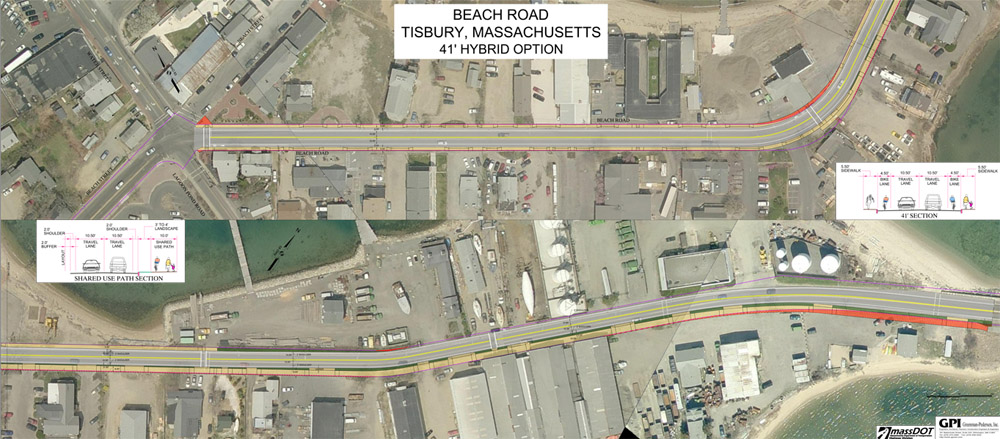In a change of direction on the Beach Road Project, Tisbury selectmen voted two to one on Tuesday to support a so called “hybrid-hybrid” plan with both a shared-use path and a symmetrical design. Last week the selectmen had voted two to one for a completely symmetrical plan.
Chairman Tristan Israel, who had been advocating for the symmetrical plan, reversed his decision saying that after speaking with Benjamin Robinson from the planning board following last week’s three hour meeting he supported a compromise.
The symmetrical design path called for sidewalks and bike lanes along the road from Five Corners to Wind’s Up. While approved by the state, this design did not meet the regional goal of an Island network of shared-use paths for off-road bicycle accommodation.
Mr. Israel had voted with Larry Gomez for the symmetrical design, while Melinda Loberg favored a hybrid plan that incorporates sidewalks and a shared-use path beginning at Tisbury Marketplace and running to Wind’s Up, where it would connect to the existing shared-use path that runs to the Lagoon Pond bridge. The bridge project also includes a shared-use path.
Planning board members and a seniorplanner from the Martha’s Vineyard Commission also favored a hybrid design. The “hybrid-hybrid” design tried to meet the desires for a north side sidewalk and off-road bicycle accommodations by running a sidewalk parallel to a shared-use path from Tisbury Marketplace to just before Packer’s Wharf. All of the designs required a one foot taking of land along the roadway.
“I would be willing to support a version of hybrid-hybrid where we work to move that [north side] sidewalk a little further toward the bridge,” said Mr. Israel, regarding his decision to change sides.
He said that at the last meeting he did not realize Mrs. Loberg would support either the hybrid or hybrid-hybrid design.
“I had been prepared earlier when the group went to talk to Mr. Packer [for a voluntary taking] to support a version that would run a sidewalk to approximately Mone’s real estate, and SUP [shared use path] on the other side,” he said.
Mr. Packer had declined voluntarily giving land for the project, and the north side sidewalk stopped short, too soon for Mr. Israel’s preferences. Mr. Israe l said his personal preference is still for a symmetrical design, but acknowledged the decision was for the town. He said he hoped through the design phase, the shared-use path could be made as safe as possible by reducing curb cuts.
Mr. Gomez continued to vote against the plan, and said he spoke for the silent majority who supported the symmetrical plan, while at the same time noting that the audience at the meeting primarily supported a shared-use path.
“I think last week we should have stayed with the two to one vote and passed that on to the state,” he said. “I’m sorry that we decided to think about this for town meeting because it’s nothing but the same arguments over and over and over again. It took us 20 years to put a sewer system in. It will take us 20 years to figure out what to do with Beach Road. I think we’re making a big mistake.”
Ms. Loberg had long been the lone voice of the selectmen advocating for a shared-use path. She said the town must continue working with the state to make the roadway as safe as possible for the different users.
“I’m in favor of whatever this new hybrid is that we’re going to evolve, because I know it will be safest,” she said.
In response to Mr. Gomez’s comment about a silent majority favoring the symmetrical plan, Ms. Loberg acknowledged the small crowd at the back of the Katharine Cornell Theatre. “I think the government is done by the people who show up, and these are the people who have taken the time to devote themselves to the issues,” she said.
Now MassDOT can begin the next steps to draw up the design and get it into biddable shape, but time is definitely a factor.
Town administrator John (Jay) Grande said the funding for the project is still in place, but the project start date has in all likelihood slipped a year.
“I don’t think this is a surprise to anyone, this decision has been pending, the town, planning board and selectmen were aware this project had a tight timeline,” he said. “The funding is still in place and should not be a significant concern, as long as the input of the town is done in a timely manner, which is to say very soon.”
Mr. Grande said perhaps through some fast tracking the project can still squeeze into fiscal year 2017.





Comments (2)
Comments
Comment policy »